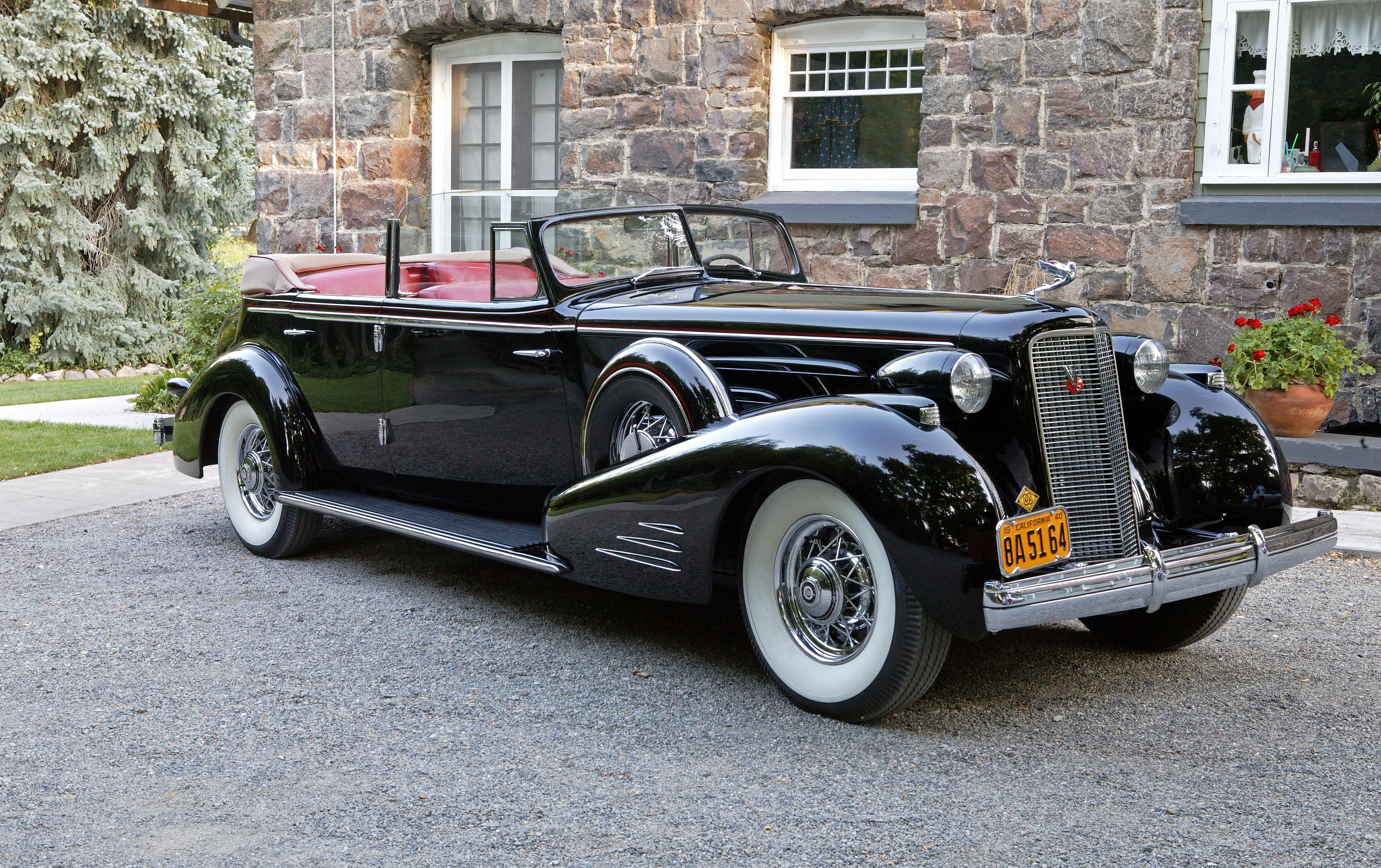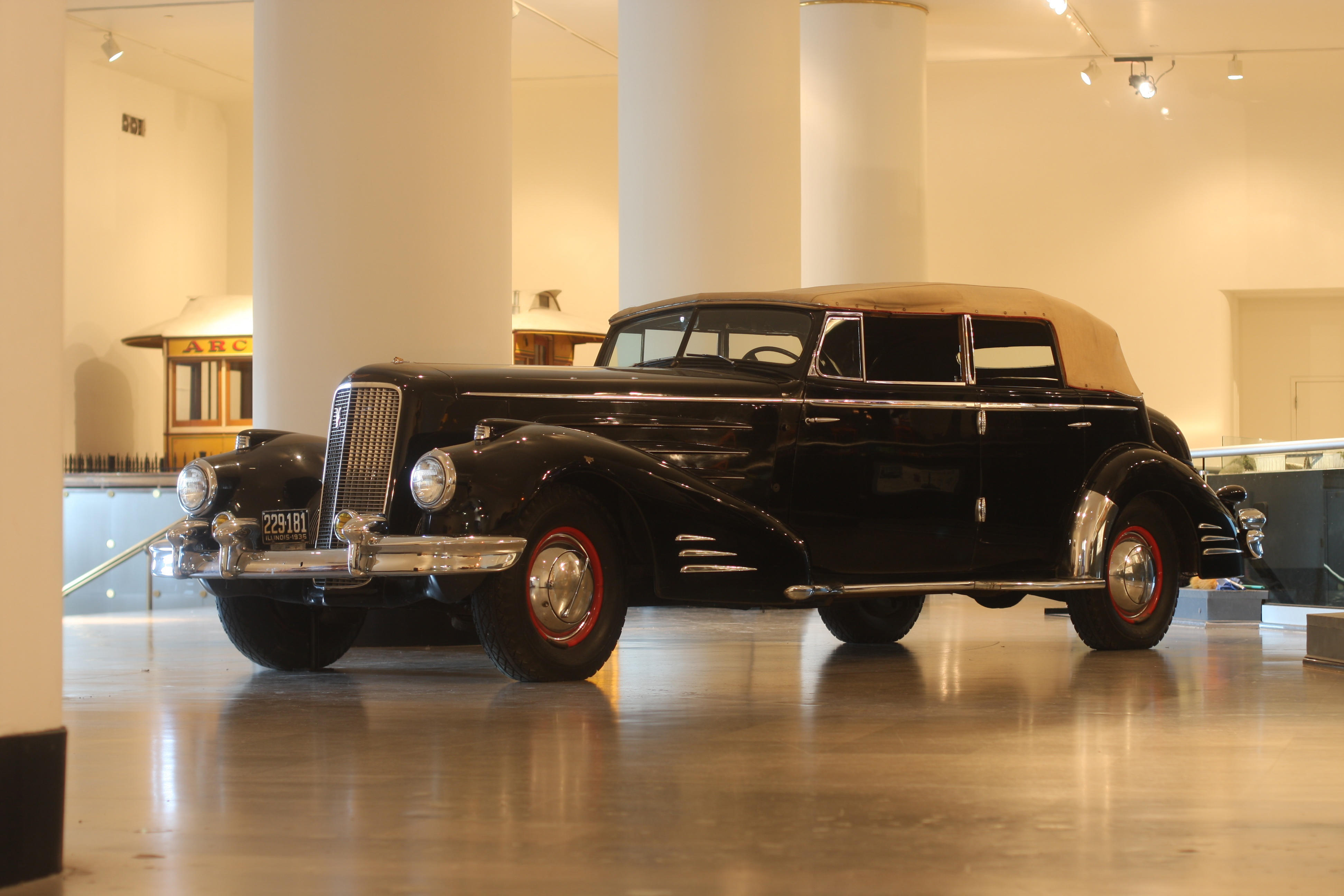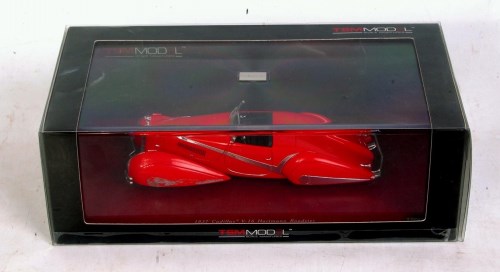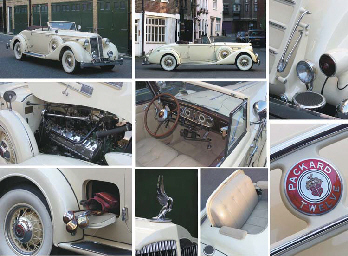1934 CADILLAC V-16 CONVERTIBLE SEDAN COACHWORK BY FLEETWOOD Chassis No. 5100023 Engine No. 5100023 Black with red leather interior Engine: V-16, overhead valve, 452.8ci, 180bhp at 3,800rpm; Gearbox: three speed manual; Suspension: semi-elliptic leaf springs front and rear. Left hand drive. As the 1920s drew to a close, General Motors under Alfred P. Sloan had only one field to conquer: the luxury end of the market. The 20s were time of opulence, and America's rich and famous had looked towards Packard and Duesenberg to fulfill their needs. Cadillac's dilemma was exactly how to overcome their rivals. A V-8 would not do. Cadillac had pioneered the V-8 in 1915 and it had already lived up to the firm's slogan "Standard of the World" through being the smoothest, most refined V-8 in production anywhere. Nor would they introduce a V-12 that would merely flatter Packard by imitation. Accordingly, chief engineer Ernest Seaholm and designer Owen Nacker were left with little choice but to go for a V-16. Seaholm brought many innovations to Cadillac's engineering, including the V-16 engine, which powered the large flowing motor car elegantly. Another of Seaholm's developments, the hydraulically-silenced overhead valves, made driving a pleasure. The twin cylinder blocks were at a 45 degree angle, each with its own updraft carburetor system. The 452ci engine developed 180 horsepower and was capable of 100mph, but it was designed for lower speeds, where it produced smooth effortless power and minimum gearshifting. A sixteen cylinder engine, for all that its perfect balance and smooth power propeled a car weighing over 6,000 pounds swiftly to 100mph, was an extravagant gesture. The V-16 set a standard of refinement unequalled by any manufacturer in the world. Its silence in operation has never been repeated and its synchromesh transmission, vacuum-assisted servo brakes and powerful engine gave it performance that could be matched only by the noisy, comparatively rough and more expensive Duesenberg. Style was the car's other hallmark, and to compliment the imposing engine, General Motors employed its Art and Color styling department, under one of the most famous automotive designers, Harley J. Earl. Earl worked his magic on the V-16, making it one of the prettiest classics ever. Even the engine compartment was aesthetically designed. 1934 was one of the premiere styling years for Cadillac coachwork. With an unbelievable 154-inch wheelbase and 240-inch total length, the 1934 V-16's were the longest cars ever built in America. The Art Deco-style coachwork featured streamlined torpedo headlights and massive pontoon fenders, inspired by racing aircraft. Unfortunately the dramatic effects of the Great Depression were begining to take hold and the luxury car market suffered. A mere 56 V-16's were produced in 1934. This car was owned for many years by a well-known collector, the late Andrew Darling. During Mr. Darlings's ownership some years ago, the V-16 was restored. Since then, it has passed through a few collections and driven only occasionally. With its many Art Deco elements and wonderfully long 154 inch wheelbase, the V-16 is considered by many enthusiasts to be one of the all time great classic era designs.
1934 CADILLAC V-16 CONVERTIBLE SEDAN COACHWORK BY FLEETWOOD Chassis No. 5100023 Engine No. 5100023 Black with red leather interior Engine: V-16, overhead valve, 452.8ci, 180bhp at 3,800rpm; Gearbox: three speed manual; Suspension: semi-elliptic leaf springs front and rear. Left hand drive. As the 1920s drew to a close, General Motors under Alfred P. Sloan had only one field to conquer: the luxury end of the market. The 20s were time of opulence, and America's rich and famous had looked towards Packard and Duesenberg to fulfill their needs. Cadillac's dilemma was exactly how to overcome their rivals. A V-8 would not do. Cadillac had pioneered the V-8 in 1915 and it had already lived up to the firm's slogan "Standard of the World" through being the smoothest, most refined V-8 in production anywhere. Nor would they introduce a V-12 that would merely flatter Packard by imitation. Accordingly, chief engineer Ernest Seaholm and designer Owen Nacker were left with little choice but to go for a V-16. Seaholm brought many innovations to Cadillac's engineering, including the V-16 engine, which powered the large flowing motor car elegantly. Another of Seaholm's developments, the hydraulically-silenced overhead valves, made driving a pleasure. The twin cylinder blocks were at a 45 degree angle, each with its own updraft carburetor system. The 452ci engine developed 180 horsepower and was capable of 100mph, but it was designed for lower speeds, where it produced smooth effortless power and minimum gearshifting. A sixteen cylinder engine, for all that its perfect balance and smooth power propeled a car weighing over 6,000 pounds swiftly to 100mph, was an extravagant gesture. The V-16 set a standard of refinement unequalled by any manufacturer in the world. Its silence in operation has never been repeated and its synchromesh transmission, vacuum-assisted servo brakes and powerful engine gave it performance that could be matched only by the noisy, comparatively rough and more expensive Duesenberg. Style was the car's other hallmark, and to compliment the imposing engine, General Motors employed its Art and Color styling department, under one of the most famous automotive designers, Harley J. Earl. Earl worked his magic on the V-16, making it one of the prettiest classics ever. Even the engine compartment was aesthetically designed. 1934 was one of the premiere styling years for Cadillac coachwork. With an unbelievable 154-inch wheelbase and 240-inch total length, the 1934 V-16's were the longest cars ever built in America. The Art Deco-style coachwork featured streamlined torpedo headlights and massive pontoon fenders, inspired by racing aircraft. Unfortunately the dramatic effects of the Great Depression were begining to take hold and the luxury car market suffered. A mere 56 V-16's were produced in 1934. This car was owned for many years by a well-known collector, the late Andrew Darling. During Mr. Darlings's ownership some years ago, the V-16 was restored. Since then, it has passed through a few collections and driven only occasionally. With its many Art Deco elements and wonderfully long 154 inch wheelbase, the V-16 is considered by many enthusiasts to be one of the all time great classic era designs.















Try LotSearch and its premium features for 7 days - without any costs!
Be notified automatically about new items in upcoming auctions.
Create an alert